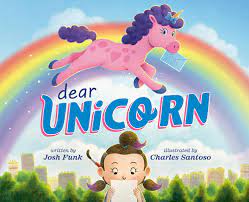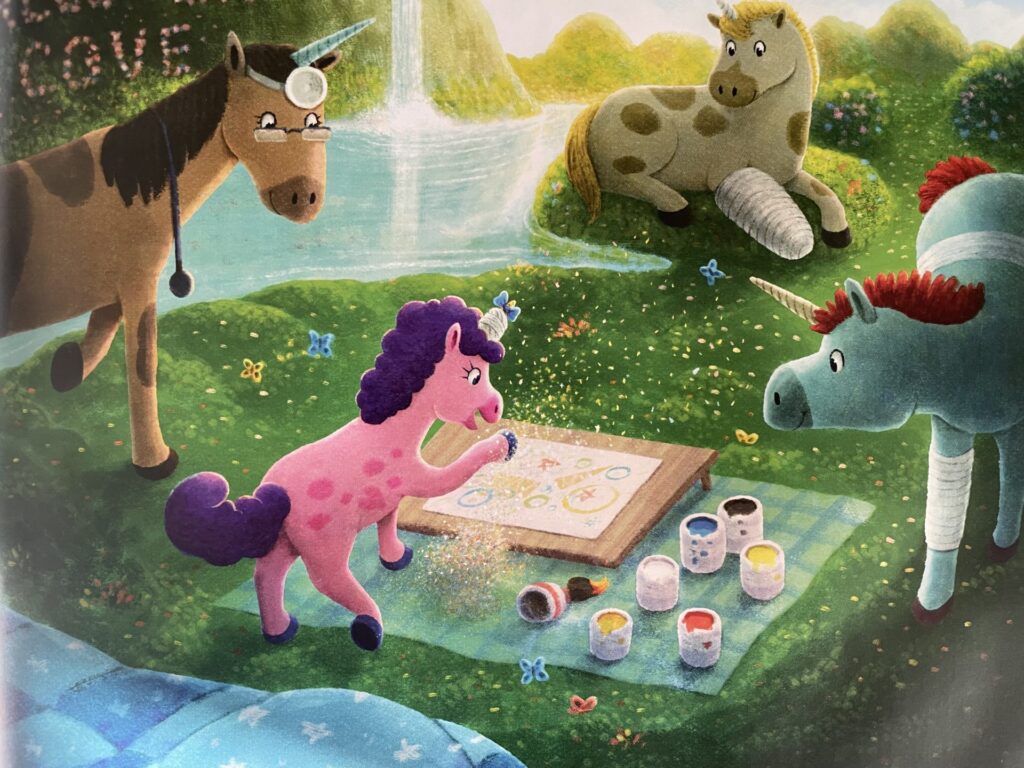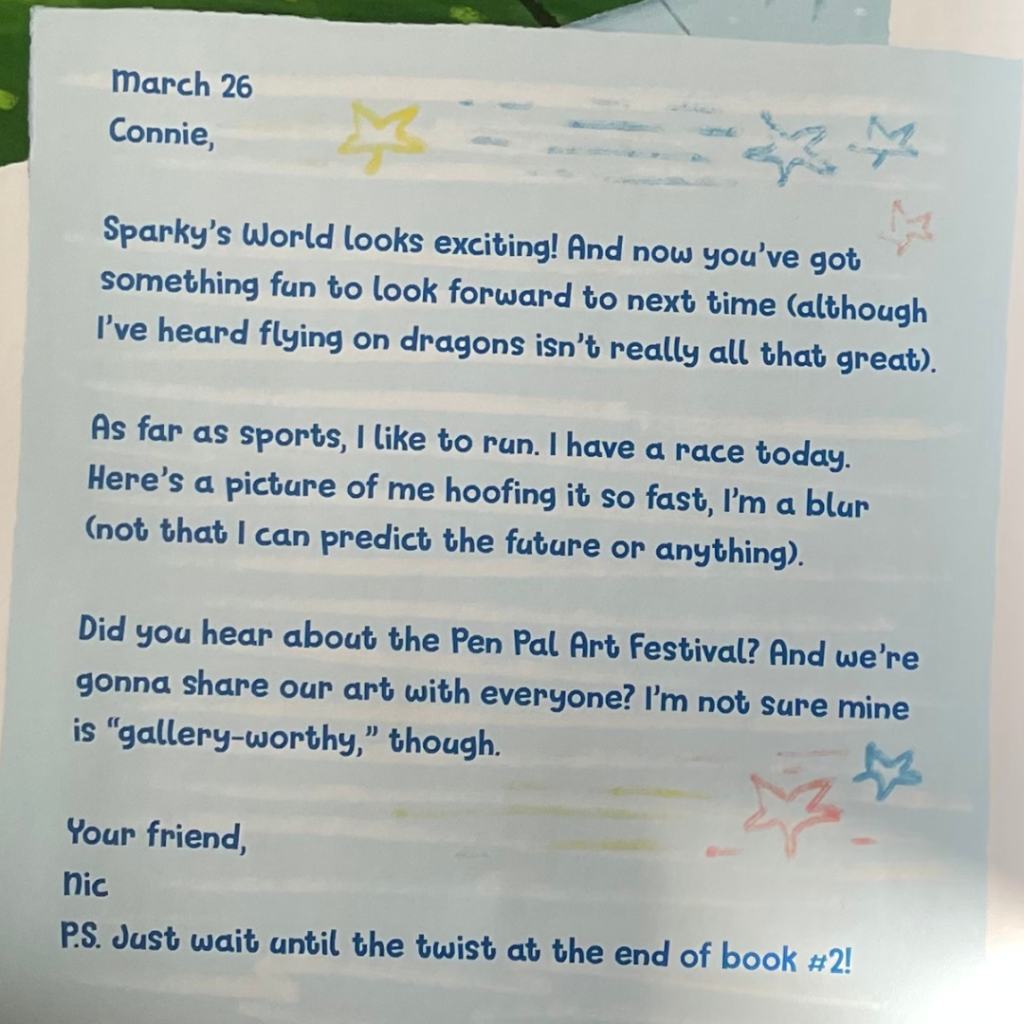
Why I Picked It Up:
Since we are known Josh Funk groupies, Penguin House reached out to let us know of his latest masterpiece! The combination of Josh Funk’s exceptional talent and the inclusion of unicorns? Yes, please!
Why I Finished It:
Josh Funk’s books are naturally delightful, and as a teacher, I find myself brimming with countless possibilities when reading them. Initially, I enjoyed the book purely for its entertainment value, but subsequent readings are focused on capturing all the potential teaching ideas. Dear Unicorn is similar to Funk’s Dear Dragon – both of which feature correspondence between unlikely pen pals. Though Dear Unicorn obviously includes a unicorn instead of a dragon, the storytelling is done in the same way – through letters. Readers get to see the letters, and then the illustrations provide insight into how each character interprets the correspondence, and throughout the story, we can observe the development of their characteristics. Overall, it’s an enjoyable read that maintains the reader’s curiosity, making us eager to discover when and how they will eventually uncover each other’s true identities.
Who I Would Recommend It To:
Teachers should have Josh Funk in the classroom, period. There is so much that can be taught with these stories. Of course, the book with hit on different levels with different ages – younger kids would totally enjoy and be amused by the story and older kids will be able to understand more of the nuances within the text and illustrations by Charles Santoso.
Integration Ideas:
Perspective & Character Attitude
Constance, aka Connie, starts off quite pessimistic in her letters. She mentions feeling weird about the assignment of writing to a pen pal, upset about having to do chores, missing her best friend who wasn’t in her class, coming in second place in a championship game as a loss, etc. Nicole, aka Nic, always interprets Connie’s messages differently than the reader knows they were meant – Nic thinks Connie views the assignment as “delightful”, that baking was super fun, that even though Connie’s best friend isn’t in her class they could eat lunch together every day, and that it was exciting that Connie almost won a championship game. There are two great classroom ideas here in this misinterpretation.

- Consider perspective. People have various viewpoints influenced by their personality and background, which can lead them to interpret situations differently from others. For instance, an individual residing in a compact one-bedroom apartment might perceive an average-sized house as spacious. On the other hand, someone living in a massive, grand residence would have a much different perception of that same average-sized house. Another illustration involves studying the historical figure, Nathan Hale. While Americans might consider him a hero, the British will likely hold a contrasting opinion or perspective. A difference in perspective can lead to some fantastic conversation in your class:
- Have students choose one of the letters back and forth between Connie and Nic and discuss how Nic puts a positive spin on Connie’s initial letter. As the story continues, help students discuss how Nic’s positive twists begin to alter how Connie initially sees situations.
- Ask students to consider how they approach situations differently when they are around positive people vs. negative people. Ask students if they were about to start a soccer game and everyone on their team was feeling sad because they just knew they were going to lose, How that would make you feel playing the game? What if everyone was positive you were going to have a great time and you might even win? How do you feel then?
- Give students different scenarios that seem negative and have them switch them to positive statements. This is a great growth mindset activity. Some scenarios might be: Getting cast as an alternate in the school play. Studying for a test that was canceled. Etc.
- Consider the two personalities: pessimist and optimist. Before rereading the text, ask students about times when they felt really happy and times when they felt sad or worried.
- Introduce the terms “optimism” and “pessimism” by explaining that optimists are people who look on the bright side of things and believe things will turn out well, while pessimists tend to focus on the negatives and always worry about what could go wrong.
- Then, as you read the text again, have students put a thumbs up every time a character is being optimistic and a thumbs down every time a character is being pessimistic.
- In the end, ask the students if they noticed a change in a character. They should notice that Connie slowly became more positive, feeding off of Nic’s energy. Ask the students to consider what caused the change.
- This is character analysis! Have students use a graphic organizer or write a response to how Connie changed and why.
Writing Letters

Dear Unicorn is the perfect way to introduce students to the world of letter writing. Teach the students the parts of a letter:
- Heading: The sender’s address and the date.
- Greeting: The way you say hello to the person you are writing to.
- Body: The main part where you write the message.
- Closing: The way you say goodbye.
- Signature: The sender’s name.
Next have groups of students choose one of the letters in the book to identify the five parts of a letter. Have students describe each part in relation to the book. What heading was used, what greeting, what specifically was in the body, which closing was used, etc.
Discuss other headings, greetings, and closings. Also, share what might be included in the body of a letter.
Now let them write one. If there’s a specific purpose or audience, this will be a much more enjoyable activity. Ideas for authentic audience:
- Write a letter to a favorite author and really send it!
- Write a letter to a friend or family member, and send it!
- Write a letter to a pen pal. Use Twitter to find a class or use a site to find pen pals.
Vocabulary: Multiple-meaning words and Idioms, Context Clues

We love words, so the opportunity to teach multiple-meaning words should not be overlooked. There is a moment in Dear Unicorn when Nic, the unicorn, breaks her horn. Not knowing she’s a unicorn, Connie assumes Nic is talking about a musical instrument. There is also a moment when Nic says in her race she was “hoofing it”, because she literally has hooves, but Connie assumed the figurative meaning of just going really quickly.
Highlight these two examples and discuss what is causing each person to understand the word or saying differently (context and background information).
Model webbing different meanings of a word, using the word horn. Write horn in the middle circle and then have each student group get a dictionary to look up the word. Take this opportunity to discuss the dictionary – how to read the different definitions, pronunciation, parts of speech, etc. Have each group read a definition of the word horn and discuss it as a class. Write it on the web. Students could be doing their own web at the same time. Then ask everyone to write a sentence for each different definition.

Next groups of students can be given a different word to do the same activity on their own.






Leave a Reply